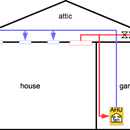Ventilation through HVAC air return
My house has no ventilation aside from the bath and kitchen exhausts. This needs to change. ASHRAE 62.2 wants me to have 66cfm, and BSC-01 42cfm. No way I’m getting that through the cracks of the windows. But I don’t want a whole ‘nother duct system. I already have ducts! Also, I don’t like the idea of exhaust-only. Where’s that air gonna come from? My crawlspace is icky!
The good news seems to be that I can just pull in outside air and distribute it through the HVAC ducts. The trick is apparently to connect the HVAC return to the outdoors, and to do it right you need to add a motorized damper and a controller like the AirCycler g2 (http://www.aircycler.com/products/aircycler-g2). That would certainly be cheap. But what do the building science gurus say? It seems they disagree. Oh what fun.
Lstiburek likes using HVAC ducts for ventilation, even uses the setup in his “perfect HVAC” (http://www.buildingscience.com/documents/insights/bsi-022-the-perfect-hvac), though he actually uses an HRV hooked up to both the supply and the return, which I agree is better, and maybe some day I’ll be able to afford it.
But Allison Bailes doesn’t like this sort of setup at all (http://www.energyvanguard.com/blog-building-science-HERS-BPI/bid/54084/Why-I-m-Not-a-Fan-of-Positive-Pressure-Mechanical-Ventilation). He worries that not having an HRV/ERV means pulling in unconditioned air, and again I agree, but there is nothing inconsistent between using an HRV and using the HVAC ducts: just hook one HRV connection to the HVAC supply and the other to the return, as Lstiburek suggests.
He also worries about a big blower wasting power pumping 1000cfm through the house just in order to pull in 100cfm of ventilation air on days where it would normally be (mostly) off. There I tend to agree more, not only because of the waste of power, but also because my HVAC blower is hella noisy.
But if that’s the problem, why not just add a small inline fan to the ventilation intake duct? You can even control it with a relay from the same wire as the damper. Home Depot has one for $33 that they claim moves 160cfm all by itself. “At what pressure?” I hear you scream — and I don’t know. I don’t think Home Depot markets these things to people who read manual D for fun. But it seems plausible that a fan like that could pull in some ventilation air and stuff it into a duct system that is way oversized for mere ventilation purposes.
The only problem I can see is that, without the furnace blower on, the ventilation air might try to enter the house through the return duct, which means passing the filter in the wrong direction and blowing dust into the house: quite the opposite of what ventilation is supposed to accomplish. So you’d have to have a backdraft damper in the return, and I cannot find any information on how much pressure those need to actually close up.
Attached are pictures of the typical system and my proposed modification. Control electronics is left as an exercise to the reader. The second damper is a manual one to tweak the flow rate.
GBA Detail Library
A collection of one thousand construction details organized by climate and house part











Replies
I tried to make a slight edit, but it got caught in a spam filter. I meant to clarify that, in my house, the filter is on the return register, not in a box near the furnace. One way to avoid the problem of air flowing the wrong direction and blowing dust into the living room could be to simply move it to be in a box near the furnace. I think that's out of fashion (correct me if I'm wrong), but I see nothing wrong with it. As for the impact of the extra motor while the blower *is* on: with one extra relay you can prevent that, but I frankly doubt it would impact the performance of the blower, especially if the branch from the return duct to the vent duct is a wye in the right direction so the air gets angled toward the furnace rather than toward the return vent.
Jacob,
There is no need for you to re-invent the wheel.
The type of ventilation system you are describing is called a central-fan-integrated supply ventilation system. It has a few advantages (it's cheap) and a few disadvantages (the ductwork isn't optimized for ventilation; exhaust ducting is not integrated; it requires a furnace with an ECM blower; and it costs more to run than an HRV).
This type of system is discussed in this article: Designing a Good Ventilation System.
Installing a duct to convey fresh outdoor air to your return-air plenum is easy; the hard parts are (a) preventing underventilation; (b) controlling overventilation; and (c) assuring affordable operation.
To prevent underventilation, you need to include an AirCycler control. The AirCycler tells the furnace blower to turn on during the swing seasons, when the thermostat doesn't call for heat or air conditioning.
To control overventilation, you need to include a motorized damper in the fresh air duct. The motorized damper is controlled by the AirCycler.
To assure affordable operation, you need to make sure that your furnace has an ECM blower. If it doesn't, your 800-watt furnace fan motor will drive your electric bills sky-high.
Jacob,
In my first response, I forgot to provide feedback on your illustrations.
1. You should never install an air handler in a garage (because of the risk that carbon monoxide fumes or fumes from stored paint, pesticides, or gasoline will enter your ductwork).
Air handlers should be installed within the home's conditioned envelope.
2. You should never install ductwork in an attic unless you have created an unvented conditioned attic by installing insulation at the roofline.